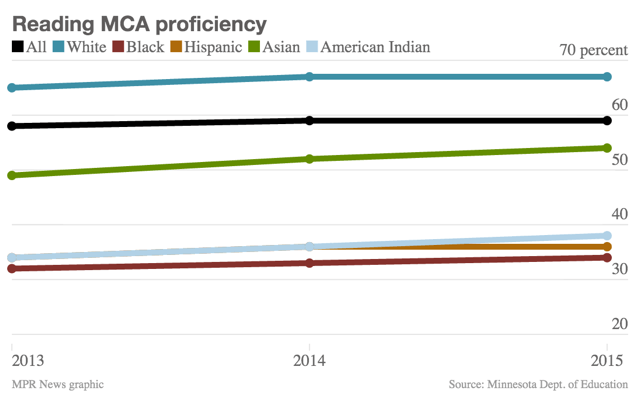Statewide testing shows little change in student scores

Minnesota students showed little change from last year in the latest round of statewide reading, math and science test results.
Reading proficiency inched up only slightly in the results released Thursday. Math scores overall were down.
And the persistent gap in scores between students of color and white students remains.
State education officials said the widely reported problems in online testing this spring had no effect overall on scores.
Create a More Connected Minnesota
MPR News is your trusted resource for the news you need. With your support, MPR News brings accessible, courageous journalism and authentic conversation to everyone - free of paywalls and barriers. Your gift makes a difference.
The test scores come from the Minnesota Comprehensive Assessments that most students take each spring. The exams measure proficiency in reading, math and science.
This year 59 percent of students overall tested proficient in reading, the same as last year and only 1 percentage point higher than two years ago.
Meanwhile, math proficiency among all students fell 1 percentage point to 62 percent.

Those aren't the results state Education Commissioner Brenda Casselius had hoped for.
"I'm never satisfied unless we see forward progress in math, science, reading," she said.
Of particular concern to Cassellius is the gap in scores between white students and students of color.
Overall, 70 percent of white students in third through eighth grade were proficient in math; 33 percent of black students met math proficiency goals.
That gap has grown slightly in each of the last two years. Results in reading scores tell a similar story.
Cassellius said the data show the state needs to continue to offer professional development for teachers in struggling schools as a way to boost test scores for students of color.
"We want to see all kids go up, but we want to see kids who have been historically underachieving ... go up faster," she said. "That's how you'll see gap closure."
Cassellius is confident that recent investments the state has made in early childhood education, like all-day kindergarten, will begin to pay off with higher MCA scores in coming years.
The state's two largest urban districts saw similarly mixed results.
"We stayed the same in our reading proficiency, we saw a slight decrease in our math proficiency and we saw a slight increase in our science proficiency," said Michelle Walker, chief executive officer for the St. Paul school district.
Walker said the district is beginning to close the achievement gap in some grade levels and at certain schools, but it's not happening fast enough, she said. She said the district will analyze the latest test data and consider adjusting curriculum.
Much like St. Paul, the Minneapolis district saw reading and math scores remain stable overall, with an increase in science scores.
Interim superintendent Michael Goar said there were bigger increases at a few of the district's struggling schools. For example, Jenny Lind Elementary School saw an increase of nearly 6 percentage points in reading scores.
Even with that increase, only 21 percent of the school's students now test proficient in reading. But Goar is confident more increases are on the way for Jenny Lind and the entire district.
"We're optimistic that what we're working on now is making some significant difference," he said. Goar thinks a new district effort to give some Minneapolis schools more freedom to make local budget, curriculum and scheduling decisions will lead to better test scores.
Hanging over this year's MCA scores was the question of whether the scores were valid at all.
Computer glitches caused delays for thousands of students during spring testing. The Department of Education halted testing on two separate days.
Education Commissioner Cassellius said an investigation found those problems did not invalidate the test scores.
"That came back to show that there was no statistical evidence to support that on average there were any impacts to statewide scores," she said.